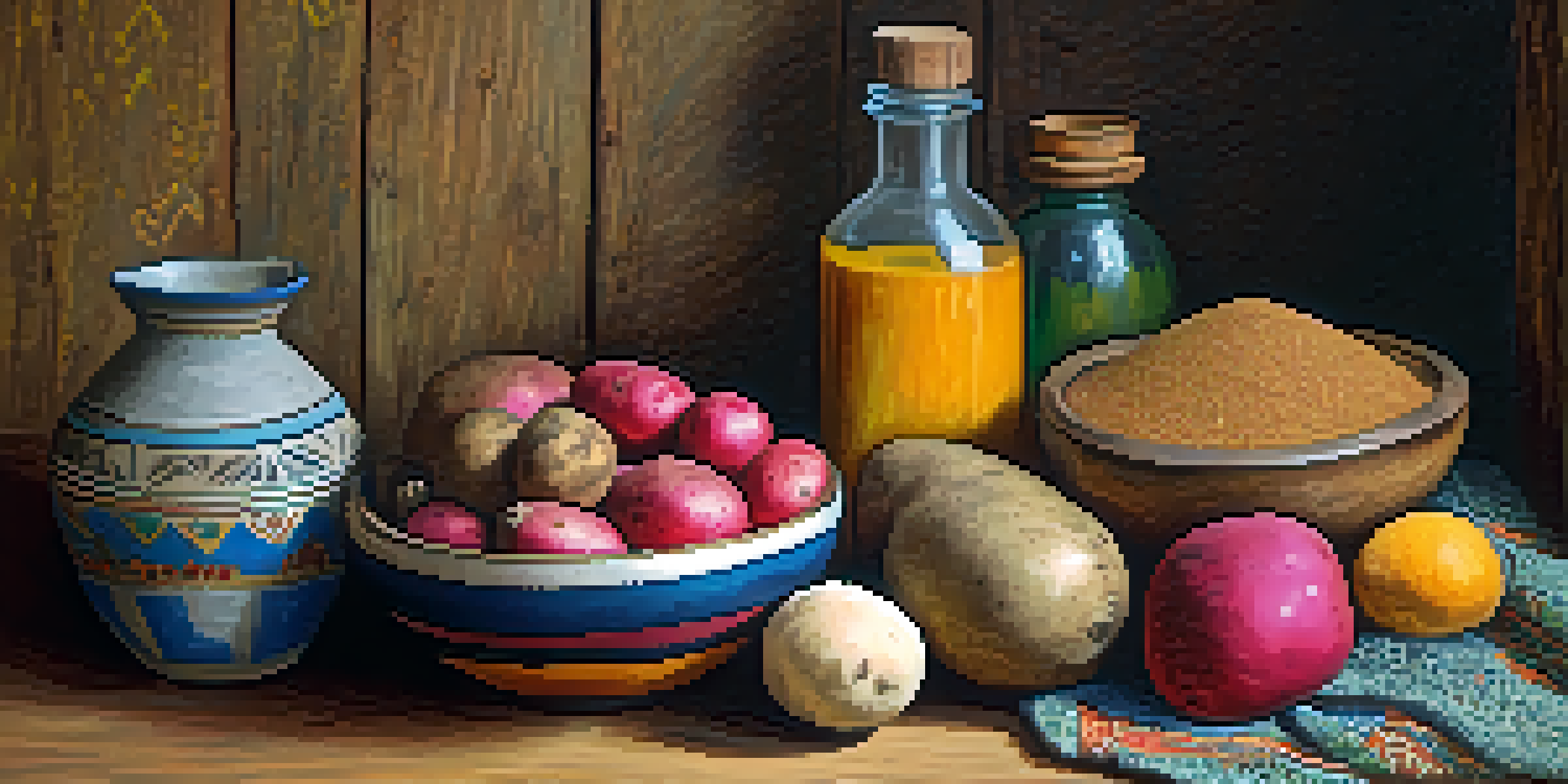Andean Ingredients: Boosting Global Culinary Creativity

Discovering the Rich Diversity of Andean Ingredients
The Andes mountains are a treasure trove of unique ingredients, from vibrant potatoes to exotic grains. Each region boasts its own specialties, rich in flavors and nutrients, that have been cultivated for centuries. This diversity not only reflects the culture but also enriches the culinary landscape globally.
Food is not just what we eat; it’s the stories we tell and the cultures we honor through each dish.
For instance, the Peruvian potato, with its over 3,000 varieties, offers a palette of colors and textures that can transform any dish. Similarly, quinoa, once a staple of the Andean diet, has now gained worldwide fame for its health benefits and versatility in recipes. These ingredients are not just foods; they tell a story of tradition and innovation.
By incorporating Andean ingredients into global cuisine, chefs can elevate their dishes, creating a fusion that celebrates both heritage and creativity. This exchange allows for new culinary narratives to emerge, inviting food lovers to explore tastes they may have never experienced before.
Nutritional Powerhouses: Health Benefits of Andean Ingredients
Beyond their unique flavors, Andean ingredients are nutritional powerhouses packed with vitamins, minerals, and antioxidants. For example, maca root, known for its energy-boosting properties, has been used for centuries by Andean communities to enhance stamina and vitality. Incorporating such ingredients into daily meals can provide a healthful boost.

Another example is amaranth, a protein-rich grain that is gluten-free and full of essential amino acids. This makes it an excellent choice for those on gluten-free diets, while also catering to the growing demand for plant-based proteins. The health-conscious consumer is increasingly looking for ingredients that not only taste good but also nourish the body.
Andean Ingredients: A Culinary Treasure
The Andes mountains offer a rich variety of unique ingredients that enhance global cuisine and tell stories of tradition and innovation.
By embracing these nutritional benefits, chefs and home cooks alike can create dishes that are both delicious and beneficial. This approach not only satisfies the palate but also aligns with the global shift towards healthier eating habits.
Culinary Innovation: Creative Uses of Andean Ingredients
The beauty of Andean ingredients lies in their versatility, allowing chefs to push the boundaries of traditional cooking. From using quinoa in salads to creating unique desserts with lucuma, the possibilities are endless. This creativity encourages culinary exploration and experimentation in kitchens around the world.
Cooking is like love. It should be entered into with abandon or not at all.
Imagine a quinoa risotto, where the traditional Italian dish is given a South American twist, or a lucuma-flavored ice cream that captivates dessert lovers. Such innovative pairings not only surprise the palate but also introduce diners to new flavor profiles and textures. This fusion of cultures in the kitchen is where true culinary magic happens.
Chefs can also draw inspiration from the vibrant colors of Andean ingredients, creating visually stunning dishes that are as appealing to the eye as they are to the taste buds. This emphasis on aesthetics combined with flavor is essential in today’s dining experience, where presentation is just as important as taste.
Sustainable Sourcing: Ethical Practices in Andean Cuisine
Sustainability is a growing concern in the culinary world, and Andean ingredients provide an opportunity for ethical sourcing. Many Andean communities practice traditional farming methods that honor the environment and promote biodiversity. By supporting these practices, chefs contribute to a more sustainable food system.
For example, when sourcing ingredients like quinoa or potatoes from local farmers, chefs can ensure that they are not only getting high-quality produce but also supporting the local economy. This connection between farm and table enriches the dining experience, as diners appreciate the stories behind their food.
Health Benefits of Andean Foods
Andean ingredients, such as maca root and amaranth, are packed with nutrients and cater to the growing demand for healthier, plant-based options.
Moreover, promoting sustainable Andean ingredients helps raise awareness about the importance of preserving these unique ecosystems. Chefs who prioritize ethical sourcing can inspire their patrons to make more informed choices about the food they consume, fostering a deeper appreciation for the origins of their meals.
Cultural Significance: The Heart of Andean Cuisine
Andean ingredients are not just food; they are steeped in cultural significance and history. Each ingredient has its own story, often linked to ancestral practices and celebrations. By understanding these connections, chefs can create dishes that honor the traditions of the Andean people.
For instance, the celebration of Inti Raymi, or the Festival of the Sun, involves traditional foods that play a crucial role in rituals. Incorporating such foods into modern menus can provide diners with a glimpse into Andean culture, making the dining experience more immersive and meaningful.
This respect for cultural heritage allows chefs to build a narrative around their dishes, inviting diners to engage not just with the flavors but also with the stories behind them. When food becomes a bridge between cultures, it fosters appreciation and understanding among diverse communities.
Global Fusion: Andean Ingredients in World Cuisine
The culinary world is increasingly embracing global fusion, and Andean ingredients are making their mark in diverse cuisines. From gourmet restaurants to home kitchens, chefs are integrating these unique flavors into everything from Asian stir-fries to Mediterranean dishes. This trend not only showcases the versatility of Andean produce but also highlights the beauty of culinary diversity.
Imagine a sushi roll infused with Andean flavors, featuring a filling of spiced potatoes or a drizzle of aji amarillo sauce. Such creative combinations not only tantalize the taste buds but also open the door to new culinary experiences that celebrate global influences.
Sustainability in Andean Cuisine
Supporting traditional farming methods in Andean communities promotes sustainability and enriches the dining experience through ethical sourcing.
As more chefs experiment with Andean ingredients, the lines between traditional and contemporary cuisine continue to blur, leading to innovative dishes that surprise and delight. This fusion of flavors encourages a dialogue between cultures, fostering a sense of community through shared culinary experiences.
Future Trends: The Growing Popularity of Andean Ingredients
As the world becomes more interconnected, the popularity of Andean ingredients continues to rise. Food enthusiasts and chefs alike are eager to explore the unique flavors and health benefits that these ingredients offer. This growing interest is not just a trend; it represents a shift towards more diverse and inclusive culinary practices.
With social media playing a significant role in influencing food trends, dishes featuring Andean ingredients are gaining visibility and acclaim. Platforms like Instagram and TikTok allow chefs to showcase their creativity, inspiring home cooks to experiment with these vibrant flavors in their own kitchens.

Looking ahead, we can expect to see even more innovative uses of Andean ingredients in global cuisine. As awareness grows, so does the potential for these ingredients to become staples in kitchens around the world, enriching culinary experiences for everyone.